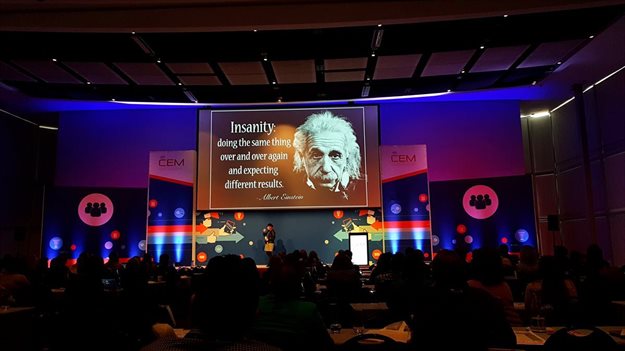You've attracted a client, but how do you keep them? Chantel Smit, CRM professional who has worked at the likes of Travelstart, Zando and Digitas Liquorice, tackled the retention phase of the customer journey at the CEM Africa Summit and showed how vital the right data is over any old 'big data'.

Smit on stage at the CEM Africa Summit.
Smit presented one of the most laugh-filled sessions of the Summit, on how vital data is in following the customer journey.
She's spent over 13 years in the field of customer relationship management or CRM and so presented a bottom-up approach, as CRM teams are often expected to "build retention journeys from rubbish data that’s not taken care of as it comes in."
She wants those in the C-Suite to understand the frustration at the bottom when this happens.
Often in CRM, the data is assessed as it's part of greater KPIs, but that becomes a number hunt, and teams tend to forget best practices in cutting corners to make more sales.
For example, we forget that behind all those numbers are real people and that everything we do in the back-end of the system affects the faces on the front end - as thus the overall customer journey.

All those numbers actually = faces.
This links to one of Smit's biggest bugbears - that there are so many data suppliers, tools and platforms competing with each other, which proves a struggle when it comes to integrating that software into your existing back-end.
Unfortunately, the big dream of a single customer view isn’t yet a reality.
Smit shares that so many integrations go wrong as the team forgot to buy a license, or has the wrong version of it, or the wrong people were in the negotiation room in the first place.
Sometimes there's a workaround hack for this, but often times it leads to a problem of overwhelming levels of new that doesn't correlate with the data you already have on your existing customers.
Nix these common CRM problems before they rear their heads
Therefore, when doing your research before investing, Smit says to check it against the competition, whether it frequently updates and offers new innovation, and whether it's easy to integrate and plug into other tools?
Most of the time, a pretty dashboard makes the sale but doesn't translate the data to insights level. You also need to ensure you get the right people to sit around the table, as custodians of the back-end infrastructure, and realise that every business has data silos, as different departments use different data systems.
Smit says she cringes at the thought of moving data across different CRM platforms or systems, as so many simply copy-paste and skip the important step of removing both hard bounce emails (those that don’t exist) and soft bounce or dormant email addresses.
Incorrectly captured data, like first names or mobile numbers showing up in the email field, is also an immensely frustrating CRM problem to fix, so we need to ensure the data is correctly input, in the first place.
Craig Johnston 11 Jul 2018 It's an ongoing problem as each form field and activation, where records are captured, tends to shows lack of attention to detail as they include domains that don’t exist, while bots inject rubbish data that's not detected if there's no double opt-in or validation of sorts.
Honing in on basic data management principles we forget as we get dazzled by what Smit calls "the bling-bling of the future".
Enhance the customer experience through gamification
She feels many CRM teams forget that first-party data in the database is money, and the data we own is usually expensive. We need to make sure it’s correct, consistent, complete, up-to-date, relevant, unambiguous, precise, free of redundancies, understandable by all involved and processable by machines.
Because CRM can and should work, and can be further enriched through gamification of certain elements, but many don't bother to get the basics right.
Enrichment campaigns can be implemented to ask for more further levels of data, which you can gamify, to make it a fun process.
Smit used the following image to demonstrate the difference between good and bad data - it's whether the picture shows you Prince William "giving you the finger," or telling you he has three kids.

Perspective is important when interpreting data...
Big data is the current big thing, with the likes of Netflix' The Great Hack scaring some about the implications. Smit says it blew her mind as it showed the scary reality of what can be done with psychographic data, as Cambridge Analytica did.
Deal with channel decay
Speaking of channels, Smit said to remember that they decay over time.
There are new channels to leverage off but it takes a team to effectively manage data, so it shouldn't be just one person's responsibility. Draw up a protocol and rules on how you use data, and implement a data health protocol.
Smit says as scary as it sounds, ask for a list of just the actives who have engaged with the brand in the last six months, then make a plan to reactivate the others, so that you minimise the risk of bad data.
Most of us are so scared of making mistakes, but Smit says to be brave and rather be like the scientist.
Be the scientist, fail forward fast
Scientists keep going through countless 'fails' to prove their hypothesis, and they make an effort to learn from each experience.
Also remember that we learn from what we try that doesn’t work, more than from what does work out the first time, so embrace your mistakes.
Smit says to take this thinking through to the rest of the company and stop putting such pressure on staff that they're scared of failure. When mistakes happen, rather lift them out of the mistake and see the true impact before punishing the staff member for something that may have different consequences to what you expect.
When building a database from scratch, it's ripe ground to experiment, like how soon to send our a follow-up emailer after the first interaction, testing send times and dates, and collecting that data effectively.

The famous 'insanity' definition. Don't be afraid to experiment!
Smit lives by this quote attributed to Albert Einstein and finds lots of businesses, unfortunately, repeat this error, just changing out the people in the role and not the role itself.
Smit ended by encouraging attendees to read up on growth science and growth hacking as a starting point to think differently, fail forward fast, be careful what you buy, get the right people in, and experiment as cohorts.
Watch for my further coverage of the CEM Africa Summit.




























